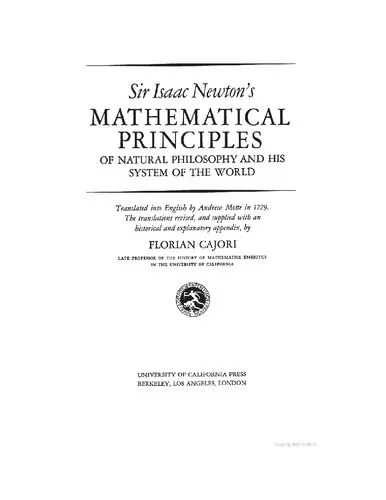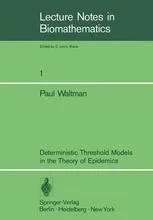Mathematical Biology: I. An Introduction
4.6
Reviews from our users

You Can Ask your questions from this book's AI after Login
Each download or ask from book AI costs 2 points. To earn more free points, please visit the Points Guide Page and complete some valuable actions.Related Refrences:
Introduction to Mathematical Biology: I. An Introduction
Mathematical Biology: I. An Introduction by J.D. Murray is a groundbreaking work that bridges the gap between mathematics and the life sciences. This book offers an insightful and accessible introduction to the field of mathematical biology, a discipline that uses mathematical techniques to understand and model biological phenomena. Aimed at advanced undergraduates, graduate students, and professionals, it lays a solid foundation in applying mathematical tools to a wide array of biological and medical problems. This book has become a classic in the field, contributing significantly to interdisciplinary research and education.
The text is meticulously structured to present both theoretical and practical approaches, gradually leading readers into its vast and exciting subject matter. Covering topics ranging from population dynamics to cell biology and from ecological models to pattern formation, Murray ensures that the biological relevance of each mathematical tool is fully explored. Each chapter is enriched with illustrations, examples, and exercises to deepen comprehension and foster hands-on application.
The book remains highly valued for its clarity, logical progression, and balance between mathematical rigor and biological interpretation. By the end of this introduction, you will gain a deeper appreciation of how mathematics helps decode the complex tapestry of life.
Detailed Summary of the Book
The book begins with an overarching introduction to mathematical biology, establishing the importance of mathematical modeling in understanding biological processes. In the early chapters, Murray explains essential mathematical methods such as ordinary differential equations and partial differential equations, which form the backbone of many biological models.
Subsequent chapters explore specific biological applications. The author illustrates how models are constructed and refined using real-world phenomena from areas like population dynamics, enzyme kinetics, neural activity, and epidemiology. For instance, the logistic growth model is extensively discussed as a way to understand population and resource limitations. The famous predator-prey model, also known as the Lotka-Volterra system, demonstrates the interplay between two species in an ecological context.
Towards the later sections, Murray delves into more sophisticated topics, such as spatial models, reaction-diffusion systems, and pattern formation in biology. These chapters illustrate how seemingly simple mathematical equations can give rise to the intricate patterns seen in nature, such as animal coat patterns or the distribution of vegetation. Each topic is explored thoroughly, always tying back to its biological relevance.
Exercises and challenges are provided throughout, often incorporating biological data to offer a practical edge to the theoretical material. The emphasis is on fostering an interdisciplinary mindset that equips readers to apply mathematical techniques in biology and beyond.
Key Takeaways
- Mathematical biology is a rapidly growing field, making it essential for modern biologists to understand key mathematical tools.
- Mathematical models can explain, predict, and sometimes even control biological systems through careful study and application.
- The book demonstrates the interplay between mathematics and biology by connecting models with real-world data and observations.
- Both analytics and numerical simulations can provide deep insights into biological phenomena.
- Interdisciplinary collaboration between mathematicians and bioscientists is critical for solving complex biological problems.
Famous Quotes from the Book
"It is not the mathematics that is difficult, but the biological complexity which we attempt to capture mathematically."
"The power of mathematics lies not in solving equations, but in understanding the world."
Why This Book Matters
Mathematical Biology: I. An Introduction is more than a textbook; it is a gateway for researchers, educators, and students to engage with some of the most pressing biological questions of our time. From understanding the spread of infectious diseases to modeling complex ecosystems and analyzing neural networks, the applications of mathematical biology are as vast as life itself. Murray's work has inspired countless readers to adopt an interdisciplinary approach, fostering collaborations that have driven advances in both theoretical and applied science.
In an era when interdisciplinary research is increasingly prioritized, this book serves as a cornerstone for anyone interested in the confluence of mathematics and biology. With its thorough explanations and captivating examples, it teaches not only the technical aspects of modeling but also the art of asking the right questions and interpreting results with biological insight. This book reminds us why mathematics is often referred to as the "language of science."
Free Direct Download
You Can Download this book after Login
Accessing books through legal platforms and public libraries not only supports the rights of authors and publishers but also contributes to the sustainability of reading culture. Before downloading, please take a moment to consider these options.
Find this book on other platforms:
WorldCat helps you find books in libraries worldwide.
See ratings, reviews, and discussions on Goodreads.
Find and buy rare or used books on AbeBooks.
1492
بازدید4.6
امتیاز50
نظر98%
رضایتReviews:
4.6
Based on 0 users review
"کیفیت چاپ عالی بود، خیلی راضیام"
Questions & Answers
Ask questions about this book or help others by answering
No questions yet. Be the first to ask!















